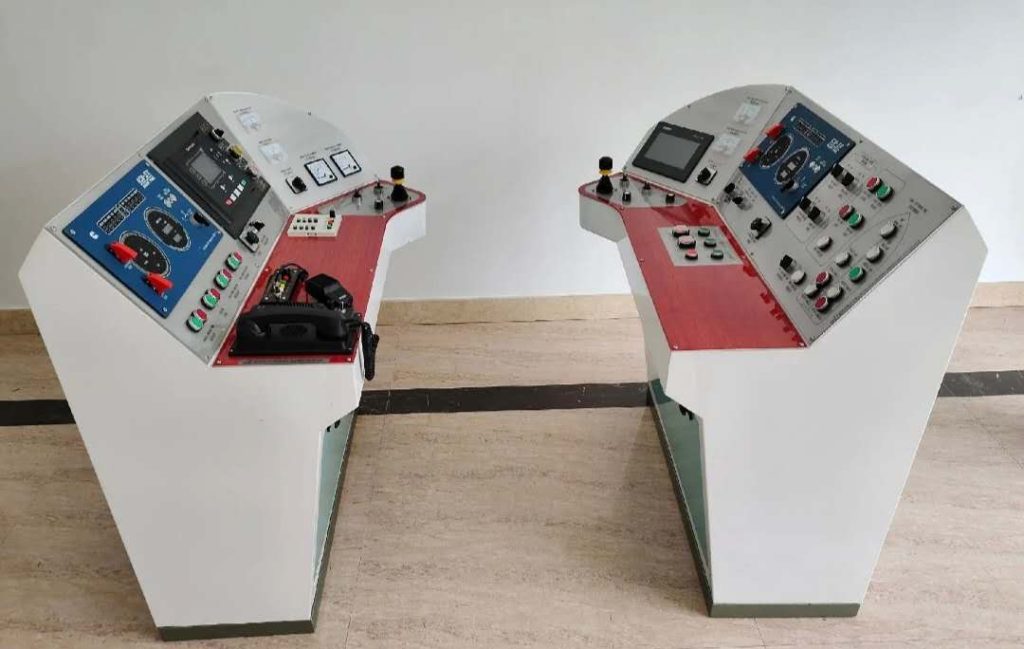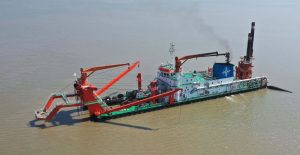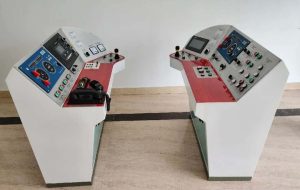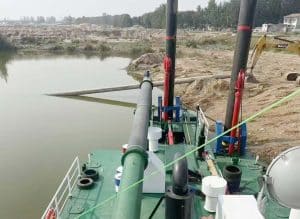🎯 Quick Facts: Cutter Suction Dredger Console
| Primary Function | Controls all dredging operations from one central location |
| Power Range | 20 kW to 4000+ kW depending on dredger size |
| Typical Depth | 15-30 meters (can reach deeper with advanced models) |
| Market Value | USD 2.5 billion (2024), projected USD 3.8 billion by 2033 |
| Key Benefits | Precision control, safety enhancement, automated operations |
What is a Cutter Suction Dredger Console?
Think of a cutter suction dredger console as the command center of a spaceship. But instead of exploring space, it controls powerful machines that move sand and mud from underwater.
A cutter suction dredger console is the central control system that manages every aspect of dredging operations. From this single location, operators can control the rotating cutter head, monitor suction pumps, and position the entire dredger with pinpoint accuracy.
Modern cutter suction dredger console featuring integrated control systems and real-time monitoring displays
The console serves as the brain of the operation. Without it, operators would need to run between different parts of the dredger to control various systems. That’s not just inefficient – it’s dangerous.
Here’s what makes these consoles so important:
- Centralized control: Everything operates from one location
- Real-time monitoring: Operators see what’s happening instantly
- Safety features: Emergency stops and automatic shutdowns protect equipment and crew
- Precision operations: GPS and sensors ensure accurate dredging
Modern cutter suction dredgers rely heavily on their console systems. These aren’t just simple control panels anymore. They’re sophisticated computer systems that can think, adapt, and even predict problems before they happen.
How Cutter Suction Dredger Consoles Work
Understanding how a cutter suction dredger console works is simpler than you might think. Let’s break it down step by step.
Step 1: Information Gathering
The console constantly receives data from sensors throughout the dredger. These sensors monitor everything from water depth to engine temperature. Think of them as the dredger’s nervous system, sending messages to the brain (the console).
Step 2: Processing and Display
The console takes all this information and displays it on screens that operators can easily understand. Instead of reading complicated numbers, operators see simple graphs, maps, and color-coded warnings.
Operator interface showing real-time dredging parameters and 3D visualization tools
Step 3: Control and Response
When operators make adjustments using the console, the system sends commands to different parts of the dredger. This happens almost instantly, ensuring smooth operations.
The console uses a hierarchical control architecture. This fancy term simply means there are two levels of computer systems working together:
“The upper system acts like a supervisor, making big decisions and monitoring everything. The lower system is like a worker, carrying out specific tasks and controlling individual machines.”
Modern consoles also feature real-time visualization tools. These show operators exactly what’s happening underwater in 3D views. It’s like having X-ray vision that lets you see through murky water to the seafloor below.
The integration of GPS and sonar systems means the console knows exactly where the dredger is and what the underwater terrain looks like. This information helps operators make better decisions and avoid problems.
Essential Components of Modern Dredger Consoles
Every cutter suction dredger console contains several key components that work together like instruments in an orchestra. Let’s explore each one and understand what it does.
Control Panels and Displays
These are the main interfaces where operators interact with the dredger. Modern displays show multiple types of information simultaneously:
- Real-time dredging depth measurements
- Cutter head position and rotation speed
- Suction pump performance data
- GPS positioning information
- Equipment status indicators
Detailed view of control panel showing hydraulic controls and monitoring systems
Navigation and Positioning Systems
GPS technology has revolutionized dredging operations. The console integrates GPS data with other sensors to provide incredibly accurate positioning. Some systems can pinpoint the dredger’s location within centimeters.
RTK (Real-Time Kinematic) systems take this accuracy even further. They account for tide changes and wave motion, ensuring that depth measurements remain precise even in rough water.
Hydraulic Control Systems
Hydraulics power most of the dredger’s movement. The console controls hydraulic systems that operate:
- Spud pole positioning (the poles that anchor the dredger)
- Cutter head swing movement
- Suction pipe articulation
- Emergency lifting mechanisms
Advanced systems include redundant hydraulic systems. This means if one system fails, a backup system immediately takes over. It’s like having a spare tire for your car, but for critical dredging operations.
Safety and Emergency Systems
Safety features are built into every component of modern consoles. Emergency stops can shut down all operations instantly. Automatic systems monitor for dangerous conditions and take protective action without waiting for human input.
Some consoles even include fiber optic networks instead of traditional wiring. This eliminates electromagnetic interference that could cause false readings or system failures.
Advanced Technologies in Today’s Dredger Consoles
The dredging industry has embraced cutting-edge technology faster than many other industries. Today’s cutter suction dredger consoles include features that seemed like science fiction just a few years ago.
Artificial Intelligence and Automation
AI systems in modern dredger consoles can make thousands of small adjustments every minute. They analyze data from multiple sensors and optimize operations automatically.
For example, unmanned intelligent dredging systems can operate with minimal human intervention. These systems use three different control strategies:
- Target parameter control: Maintains steady dredging at preset values
- Target and maximum productivity control: Adjusts speed for optimal output
- Economic productivity control: Balances fuel use with production efficiency
Advanced AI-powered console interface displaying predictive maintenance alerts and automated control parameters
Digital Twin Technology
Some consoles now create digital twins of the dredging operation. A digital twin is like a computer simulation that mirrors exactly what’s happening in real life. This technology helps operators:
- Predict equipment failures before they happen
- Test different strategies without risk
- Train new operators safely
- Optimize fuel consumption
Remote Monitoring and Control
Modern consoles enable remote operation from anywhere in the world. Supervisors can monitor dredging operations from their office, home, or even while traveling. This capability provides several benefits:
“Remote monitoring allows experts to assist with complex operations without being physically present. This saves time, reduces costs, and improves safety by keeping personnel away from hazardous areas.”
Predictive Maintenance Systems
Instead of waiting for equipment to break down, modern consoles predict when maintenance is needed. They analyze patterns in vibration, temperature, and performance data to identify potential problems early.
This approach, combined with comprehensive maintenance strategies, significantly reduces unexpected downtime and repair costs.
Environmental Efficiency Improvements
Environmental protection is increasingly important in dredging operations. Modern consoles include features that minimize environmental impact:
- Automatic turbidity monitoring to prevent excessive sediment clouds
- Fuel efficiency optimization to reduce emissions
- Noise reduction controls for sensitive areas
- Wildlife detection systems to avoid protected species
Industry Applications and Performance Data
Understanding where and how cutter suction dredger consoles are used helps appreciate their importance in modern infrastructure development.
Primary Applications
Cutter suction dredgers equipped with advanced consoles serve multiple industries:
Port Maintenance and Development: Ports worldwide rely on dredging to maintain shipping channels and create new berthing areas. The precision offered by modern consoles ensures minimal disruption to port operations while maximizing efficiency.
Land Reclamation Projects: Countries like Singapore, Netherlands, and UAE have used dredging extensively for land reclamation. Console-controlled dredgers can create new land with incredible precision, following exact specifications for depth and material placement.
Large-scale dredging operation for coastal development project utilizing advanced console control systems
River and Waterway Management: Maintaining navigable waterways requires regular dredging. Console systems help operators work efficiently while minimizing environmental impact on sensitive river ecosystems.
Mining Operations: Underwater mining for sand, gravel, and minerals depends heavily on precise console control. The accuracy provided by modern systems directly impacts profitability and safety.
Performance Specifications
Modern cutter suction dredger consoles control equipment with impressive capabilities:
| Specification | Range | Application |
|---|---|---|
| Cutter Power | 20 kW – 4000+ kW | Small rivers to major ports |
| Dredging Depth | 15-30+ meters | Standard to deep-water operations |
| Production Capacity | 1,000-15,000+ m³/day | Project-dependent output |
| Positioning Accuracy | ±2-5 centimeters | High-precision applications |
Market Growth and Economic Impact
The dredging equipment market shows strong growth driven by infrastructure development and environmental projects. Current market data indicates:
- 2024 market value: USD 2.5 billion
- Projected 2033 value: USD 3.8 billion
- Annual growth rate: 5.5-7% CAGR
- Key growth drivers: Port expansion, coastal protection, resource extraction
This growth directly correlates with increasing demand for sophisticated console systems. Projects like the Lagos-Calabar coastal road development demonstrate how large-scale infrastructure projects drive innovation in dredging technology.
Maintenance and Troubleshooting Guide
Proper maintenance of cutter suction dredger consoles ensures reliable operation and extends equipment life. Like any sophisticated system, consoles require regular attention and prompt problem-solving.
Routine Maintenance Procedures
Daily maintenance tasks keep console systems running smoothly:
Visual Inspections: Start each day by checking all displays for proper function. Look for cracked screens, loose connections, or unusual indicator lights. These simple checks can prevent major problems.
Cleaning Procedures: Salt spray and dust can damage sensitive electronics. Clean console surfaces daily with appropriate cleaning solutions. Pay special attention to ventilation areas where dust accumulates.
Software Updates: Modern consoles run on computer systems that require regular updates. Schedule updates during maintenance windows to avoid disrupting operations.
Routine maintenance being performed on console control systems and monitoring equipment
Common Issues and Solutions
Understanding common problems helps operators respond quickly when issues arise:
Display Problems: Screen flickering or blank displays often indicate power supply issues or loose cable connections. Check power connections first, then examine display cables for damage.
Communication Errors: When the console cannot communicate with other systems, the problem usually lies in network connections. Fiber optic systems are generally more reliable than traditional wiring, but connections still require regular inspection.
Sensor Malfunctions: Incorrect readings from depth sensors or GPS systems can seriously impact operations. Regular calibration prevents most sensor problems. Keep spare sensors on board for quick replacement when needed.
Troubleshooting Steps
Follow these systematic steps when problems occur:
- Document the problem: Record exactly what happened and when
- Check for obvious causes: Loose connections, power issues, or operator error
- Consult error codes: Modern systems provide diagnostic codes that pinpoint problems
- Test individual components: Isolate the problem by testing systems one at a time
- Implement temporary solutions: Keep operations running while planning permanent repairs
When to Seek Professional Help
Some problems require expert assistance. Contact professional support when:
- Safety systems malfunction or show error codes
- Multiple systems fail simultaneously
- Software crashes repeatedly despite restarts
- Hydraulic control systems become unresponsive
- Navigation accuracy degrades significantly
Remember that modern pump systems and consoles are interconnected. Problems in one area often affect other systems, making professional diagnosis valuable for complex issues.
Frequently Asked Questions
Q1: What is the primary function of the cutter suction dredger console?
A1: The console serves as the central command center for all dredging operations. It controls cutter head rotation, suction pump operation, dredger positioning through spud poles and anchor systems, and navigation. The console also monitors performance in real-time, ensuring precise and efficient dredging while maintaining safety standards.
Q2: How does the console improve dredging accuracy?
A2: Console systems integrate GPS technology, underwater sensors, and positioning systems to achieve centimeter-level accuracy. The combination of RTK positioning, sonar mapping, and automated control systems allows operators to follow exact dredging profiles. Real-time feedback ensures the dredger stays on course and maintains proper depth throughout operations.
Q3: What are the latest technological advancements in dredger consoles?
A3: Recent advances include AI-powered automation that can operate with minimal human intervention, digital twin technology for predictive maintenance, remote monitoring capabilities accessible via smartphones, and environmental monitoring systems. These technologies improve efficiency, reduce costs, and minimize environmental impact while enhancing operational safety.
Q4: How often should the dredger console and related systems be maintained?
A4: Daily visual inspections and cleaning are essential, with more comprehensive maintenance performed weekly or monthly depending on operating conditions. Software updates should occur during scheduled maintenance windows. Professional servicing is typically required annually or after every 2,000 operating hours, whichever comes first.
Q5: Can cutter suction dredger consoles be operated remotely?
A5: Yes, modern consoles increasingly support remote operation through secure internet connections. Remote monitoring allows supervisors to track operations from anywhere, while some systems permit full remote control. This capability improves safety by keeping personnel away from hazardous areas and enables expert assistance from distant locations.
Q6: What happens if the console system fails during operations?
A6: Modern dredgers include redundant systems and emergency controls. If the main console fails, backup systems automatically engage, and manual emergency controls allow safe shutdown of all operations. Spud carrier systems and other critical components have independent emergency controls to ensure crew safety.
Future of Dredger Console Technology
The future of cutter suction dredger console technology promises even more impressive capabilities. Industry trends point toward greater automation, improved environmental protection, and enhanced connectivity.
Emerging Automation Trends
Fully autonomous dredging operations are becoming reality. Future consoles will require minimal human oversight, with AI systems making complex decisions based on real-time environmental data. These systems will optimize operations continuously, adjusting parameters thousands of times per hour for maximum efficiency.
Machine learning algorithms will analyze historical data to predict optimal dredging strategies for different conditions. This means each project will benefit from the accumulated knowledge of previous operations worldwide.
Concept visualization of next-generation dredger console featuring advanced AI integration and holographic displays
Environmental Innovation Focus
Future consoles will integrate more sophisticated environmental monitoring. Real-time water quality sensors will adjust operations to minimize ecological impact. Wildlife detection systems will automatically modify dredging patterns to protect marine life.
Carbon footprint optimization will become standard, with consoles automatically selecting the most fuel-efficient operational parameters. Some systems may integrate with renewable energy sources, reducing dependence on fossil fuels.
Enhanced Connectivity and Data Sharing
5G and satellite connectivity will enable seamless data sharing between dredgers, project managers, and environmental agencies. Real-time reporting will satisfy regulatory requirements automatically while keeping all stakeholders informed.
Blockchain technology may ensure data integrity and transparency in large projects involving multiple contractors and regulatory bodies.
What to Expect in the Next 5 Years
Industry experts predict several key developments:
- Holographic displays: 3D projections showing underwater terrain and equipment positions
- Voice control integration: Natural language commands for routine operations
- Augmented reality overlays: Additional information displayed over real-world views
- Quantum computing integration: Extremely complex calculations for optimization
- Autonomous fleet coordination: Multiple dredgers working together without human coordination
These advances will make dredging operations safer, more efficient, and more environmentally friendly. The evolution of dredging automation technology continues accelerating as companies invest heavily in research and development.
Training programs will evolve to focus more on system oversight and problem-solving rather than manual control. Operators will become system managers, supervising multiple automated processes simultaneously.
Conclusion
Cutter suction dredger consoles have transformed from simple control panels into sophisticated command centers that rival those found in modern aircraft or spacecraft. These systems combine advanced technology with practical functionality to deliver precise, efficient, and safe dredging operations.
The integration of AI, GPS technology, and real-time monitoring has made dredging more accurate and environmentally responsible than ever before. As technology continues advancing, we can expect even more impressive capabilities that will further revolutionize the industry.
Whether you’re involved in port development, land reclamation, or environmental restoration, understanding cutter suction dredger console technology helps you make informed decisions about equipment selection and project planning. The future of dredging lies in these intelligent systems that make complex operations seem simple.
For those considering dredging projects, working with experienced manufacturers who understand both current technology and future trends ensures access to the most capable and reliable console systems available.







